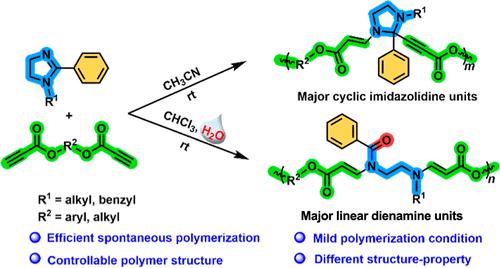当前位置:
X-MOL 学术
›
Macromolecules
›
论文详情
Our official English website, www.x-mol.net, welcomes your
feedback! (Note: you will need to create a separate account there.)
Solvent and Water Enabled Control of Alkyne-Base Polymerization Triggered by a Spontaneous Imine-Yne Click Reaction
Macromolecules ( IF 5.1 ) Pub Date : 2024-02-22 , DOI: 10.1021/acs.macromol.3c02416 Jie Chen 1, 2 , Xinyu Xu 1, 2 , Qing Xia 1, 2 , Jia Wang 1, 2 , Anjun Qin 1, 2 , Ben Zhong Tang 2, 3, 4
Macromolecules ( IF 5.1 ) Pub Date : 2024-02-22 , DOI: 10.1021/acs.macromol.3c02416 Jie Chen 1, 2 , Xinyu Xu 1, 2 , Qing Xia 1, 2 , Jia Wang 1, 2 , Anjun Qin 1, 2 , Ben Zhong Tang 2, 3, 4
Affiliation

|
The control of the polymer structure is a pivotal factor in imparting a wide range of desirable properties to polymers. However, existing methods often entail harsh conditions and laborious procedures. In this study, we demonstrate that solvent and water play a crucial role in the facile regulation of cyclic imidazolidine and linear dienamine units in the polymer chains produced by the facile polymerization of imidazolines and ester alkynes, which was triggered by the spontaneous imine-yne click reaction. Notably, when carried out in acetonitrile, the yielded polymers predominantly feature cyclic imidazolidine structures (up to 96%), whereas those synthesized in chloroform in the presence of water are predominantly characterized by linear dienamine structures (up to 91%). These structural variances give rise to diverse properties in the polymers, including variations in glass transition temperatures, Raman signals, nontraditional luminescence, refractive indices, etc. Moreover, the reaction mechanism was unambiguously proposed based on model reaction studies, shedding light on the underlying chemical processes driving these distinct results. The ability to control polymer structure through solvents and water offers a promising avenue for tailoring polymer properties, unlocking new opportunities for advanced materials design.
中文翻译:

溶剂和水控制自发亚胺-炔点击反应引发的炔基聚合
聚合物结构的控制是赋予聚合物各种所需性能的关键因素。然而,现有的方法通常需要苛刻的条件和繁琐的程序。在这项研究中,我们证明溶剂和水在咪唑啉和酯炔的轻松聚合产生的聚合物链中环状咪唑烷和线性二烯胺单元的轻松调节中发挥着至关重要的作用,这是由自发的亚胺-炔点击引发的反应。值得注意的是,当在乙腈中进行时,所得聚合物主要具有环状咪唑烷结构(高达96%),而在水存在下在氯仿中合成的聚合物主要具有线性二烯胺结构(高达91%)。这些结构差异导致聚合物具有不同的性能,包括玻璃化转变温度、拉曼信号、非传统发光、折射率等的变化。此外,基于模型反应研究明确提出了反应机理,揭示了潜在的化学性质驱动这些不同结果的过程。通过溶剂和水控制聚合物结构的能力为定制聚合物性能提供了一条有前途的途径,为先进材料设计带来了新的机遇。
更新日期:2024-02-22
中文翻译:

溶剂和水控制自发亚胺-炔点击反应引发的炔基聚合
聚合物结构的控制是赋予聚合物各种所需性能的关键因素。然而,现有的方法通常需要苛刻的条件和繁琐的程序。在这项研究中,我们证明溶剂和水在咪唑啉和酯炔的轻松聚合产生的聚合物链中环状咪唑烷和线性二烯胺单元的轻松调节中发挥着至关重要的作用,这是由自发的亚胺-炔点击引发的反应。值得注意的是,当在乙腈中进行时,所得聚合物主要具有环状咪唑烷结构(高达96%),而在水存在下在氯仿中合成的聚合物主要具有线性二烯胺结构(高达91%)。这些结构差异导致聚合物具有不同的性能,包括玻璃化转变温度、拉曼信号、非传统发光、折射率等的变化。此外,基于模型反应研究明确提出了反应机理,揭示了潜在的化学性质驱动这些不同结果的过程。通过溶剂和水控制聚合物结构的能力为定制聚合物性能提供了一条有前途的途径,为先进材料设计带来了新的机遇。


















































 京公网安备 11010802027423号
京公网安备 11010802027423号